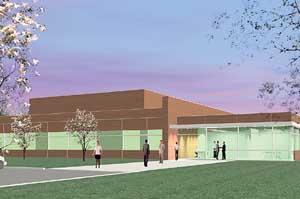University receives $17 million grant to build Ricketts biosafety laboratory
By Steve KoppesNews Office
 The Howard T. Ricketts Laboratory, which will be built near Argonne National Laboratory, is shown here in an artist’s rendering. Stringent guidelines for design, construction and operations will protect those who work in and near the Ricketts Laboratory and those who live nearby. Before construction starts, environmental analyses that began with the initial building design will be completed and approved. |
The laboratory, a Regional Biocontainment Laboratory at Argonne National Laboratory, will support research for the detection, prevention and elimination of diseases such as anthrax, hemorrhagic fever, influenza and plague. The University will acquire an additional $13 million from other sources to complete the laboratory.
The new University facility is one of nine regional and two national biosafety laboratories announced by the NIAID on Tuesday, Sept. 30. The facility, to be called the Howard T. Ricketts Laboratory, will support research conducted by the new Regional Center of Excellence for Biodefense and Emerging Infectious Diseases Research that NIAID awarded to the University earlier in September. The regional center is a collaboration of 14 Midwestern institutions led by Chicago and Northwestern University.
“Microbiology and infectious disease research are essential for the prevention and treatment of human diseases,” said Thomas Rosenbaum, Vice President for Research and for Argonne National Laboratory. “Building this new biosafety laboratory will help transform the Midwest into a center for microbiology research and permit us and our partner institutions to take full advantage of the unique structural biology and computational resources already in place at Argonne.”
The biosafety laboratory’s research will encompass many emerging diseases, such as West Nile Fever and drug-resistant tuberculosis along with influenza, plague and other perennial threats to human health.
“Few laboratories in the United States are capable of safely working on multiple microbes that cause diseases such as anthrax, plague and hemorrhagic fever,” said Olaf Schneewind, Professor in Molecular Genetics & Cell Biology, who heads the project. “The express purpose and specific design of the Regional Biocontainment Laboratory is to generate the very best science and technology in a central, state-of-the-art facility to produce drugs, vaccines and diagnostic devices to counter bioterrorism and emerging infectious diseases.”
Small laboratories already exist at the University and Argonne for safely studying infectious microbes, but the new laboratory will encompass 54,100 gross square feet (27,500 net square feet) and will enable researchers to simultaneously study four or more different pathogens. Flad & Associates of Madison, Wisc., produced the initial laboratory design. The company has designed infectious diseases laboratories from coast to coast for government, corporate, academic and not-for-profit organizations.
Stringent guidelines for design, construction and operations will protect those who work in and near the Ricketts Laboratory and those who live nearby. Before construction starts, environmental analyses that began with the initial building design will be completed and approved. These in-depth site studies, in conjunction with refinements to the laboratory’s design, will meet or exceed all requirements established by the National Environmental Policy Act. The environmental analysis process, including review and approval by the National Institutes of Health (parent agency of NIAID) and the U.S. Department of Energy (which owns the land and will lease it to the University), is expected to take at least nine months.
The Ricketts Laboratory is named for Howard Ricketts (1871-1910), a Chicago faculty member who discovered the organisms that cause Rocky Mountain spotted fever and typhus.
The University’s partners in the Regional Center of Excellence are Northwestern University; Argonne National Laboratory; Battelle Memorial Institute; Illinois Institute of Technology Research Institute; the Mayo Clinic; the Medical College of Wisconsin; Michigan State University; the University of Notre Dame; Purdue University; the University of Illinois, Urbana-Champaign; the University of Illinois, Chicago; the University of Michigan; and the University of Wisconsin, Madison.
For more information about the Ricketts Laboratory, see http://www.htrl.uchicago.edu/. For more information about the Regional Center of Excellence, see the University of Chicago Chronicle, Sept. 25, Vol. 23, No. 1, at http://chronicle.uchicago.edu/030925/rce.shtml.
![[Chronicle]](/images/sidebar_header_oct06.gif)